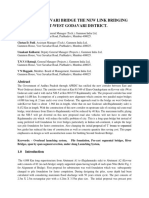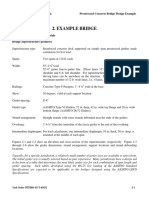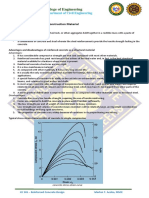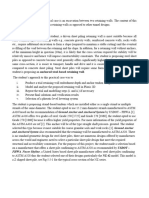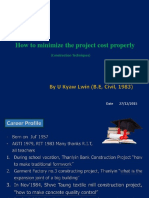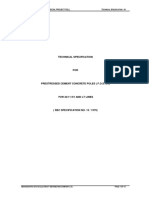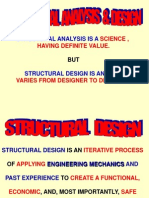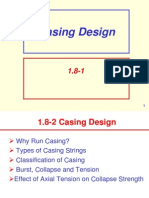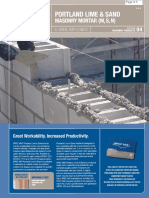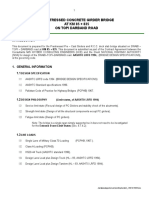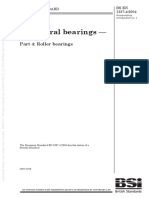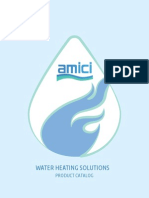Analysis, Design and Construction of Tie-Back Anchor For Coffer Dam
Analysis, Design and Construction of Tie-Back Anchor For Coffer Dam
Uploaded by
Thanh Bình HuỳnhCopyright:
Available Formats
Analysis, Design and Construction of Tie-Back Anchor For Coffer Dam
Analysis, Design and Construction of Tie-Back Anchor For Coffer Dam
Uploaded by
Thanh Bình HuỳnhOriginal Title
Copyright
Available Formats
Share this document
Did you find this document useful?
Is this content inappropriate?
Copyright:
Available Formats
Analysis, Design and Construction of Tie-Back Anchor For Coffer Dam
Analysis, Design and Construction of Tie-Back Anchor For Coffer Dam
Uploaded by
Thanh Bình HuỳnhCopyright:
Available Formats
International Journal of Civil Engineering and Technology (IJCIET)
Volume 7, Issue 6, November-December 2016, pp. 371–377, Article ID: IJCIET_07_06_040
Available online at http://www.iaeme.com/IJCIET/issues.asp?JType=IJCIET&VType=7&IType=6
ISSN Print: 0976-6308 and ISSN Online: 0976-6316
© IAEME Publication
ANALYSIS, DESIGN AND CONSTRUCTION OF
TIE-BACK ANCHOR FOR COFFER DAM
H.P. Santhosh
Assistant Professor, Department of Civil Engineering,
MSRUAS, Bengaluru, Karnataka. India
R.K. Chethan Gowda
Assistant Professor, Department of Civil Engineering,
MSRUAS, Bengaluru, Karnataka, India
Dr. H.M. Rajashekhara Swamy
Professor & Head, Department of Civil Engineering,
MSRUAS, Bengaluru, Karnataka, India
ABSTRACT
The concept of a rock anchor system is to create an internally stable mass of soil and also to
stabilize the cofferdam that will resist external forces at an adequate level of serviceability. The
analysis and design of rock anchor concentrates on achieving secure against a range of potential
failure conditions of cofferdam. The design should limit movements of the soil and the cofferdam
while providing a practical and economical basis for construction. The design should consider the
mobilization of resistance by both anchors and cofferdam elements in response to loads applied to
the cofferdam particularly sea water [3].
This paper deals with the analysis, design and installation of cement grouted rock/ground
anchors and anchored systems. The analysis, design and construction procedure have been
demonstrated through a series of numerical analyse sand a parametric study has also been carried
out based on different anchorage capacity. It is concluded that 150 ton anchor capacity is effective
in controlling horizontal displacement of cofferdam at different levels. Also this paper deals with
the step by step analysis, design and construction procedure implemented at construction site.
Key words: Coffer dam, Pre-stressed Anchor, Grout, Bond length, Free length
Cite this Article: H.P. Santhosh, R.K. Chethan Gowda and Dr. H.M. Rajashekhara Swamy,
Analysis, Design and Construction of Tie-Back Anchor for Coffer Dam. International Journal of
Civil Engineering and Technology, 7(6), 2016, pp.371–377.
http://www.iaeme.com/IJCIET/issues.asp?JType=IJCIET&VType=7&IType=6
1. INTRODUCTION
The concept of a rock anchor system is to create an internally stable mass of soil and also to stabilize the
cofferdam that will resist external forces at an adequate level of serviceability. The analysis and design of
rock anchor walls concentrates on achieving a final constructed cofferdam that is secure against a range of
potential failure conditions [6]. The design should limit movements of the soil and the cofferdam while
http://www.iaeme.com/IJCIET/index.asp 371 editor@iaeme.com
H.P. Santhosh, R.K. Chethan Gowda and Dr. H.M. Rajashekhara Swamy
providing a practical and economical basis for construction. The design should consider the mobilization
of resistance by both anchors and cofferdam elements in response to loads applied to the cofferdam.
A rock anchor is a long, high capacity reinforcement comprising a tube fixed into rock and tensioned to
a predetermined load. Rock anchors are used widely to improve the stability and load bearing
characteristics of a rock mass [4]. Cable rock anchors utilize bundles of steel wires to form a fixed
anchorage depth. In general the anchor length should under no circumstances should be less than either
2.5m or the free length less than 5m.
This paper deals mainly, but not exclusively, with the analysis and design of large anchors of the type
shown in Fig. 1 and with their application in cofferdam engineering, particularly for concrete gravity,
buttress and arch dams using STAAD Pro.
Figure 1 Brief Details of Rock Anchor
2. DESIGN BASICS
For designing 137 Ton capacity Rock Anchor
Taking total stress losses to 15% the anchor is designed for=137+20.55=157.55 Tons.
The following are to be evaluated
• Number of 15.2mm dia strands
• Bond length of anchor
3. MATERIAL PROPERTIES
3.1. Pre-stressing Strands
15.2 mm diameter seven wire pre-stressed strands
Table 1 Design parameters assumed in calculations
Components Assumed Parameters Remarks
Bond strength at Ultimate bond As per BS 8081/ IS:
Soil/Grout interface stress=0.4N/mm2 1343-1980
Bond strength at Ultimate bond As per BS 8081/ IS:
rout/Strand interface stress=0.4N/mm2 1343-1980
http://www.iaeme.com/IJCIET/index.asp 372 editor@iaeme.com
Analysis, Design and Construction of Tie-Back Anchor for Coffer Dam
Table 2 Safety factors used in design
Components Required F.O.S Remarks
Strand 2 As per BS 8081/ IS:
1343-1980
Rock/Grout Interface 2 As per BS 8081/ IS:
1343-1980
Grout/Strand Interface 2 As per BS 8081/ IS:
1343-1980
4. DESIGN FOR 157.55 TON ANCHOR FORCE
4.1. Design Parameters
Working load =157.55 Ton
Free length =variable
Drill hole dia. =150mm
4.2. Strand Properties
7 wires pre-stressing strands conforming to ASTM standards
Diameter =15.2 mm
Nominal Area=181mm2
Ultimate strength =260kN=26.0 Ton
4.3. Calculations
Number of strands required
∗
=
ℎ
157.55 ∗ 2
= = 12.119 ~12
26
Bond length required at Ground/Rock Interface
∗
=
"∗# .∗ $
157.55 ∗ 9.81 ∗ 2
= = 16.399~17
" ∗ 150 ∗ 0.4
http://www.iaeme.com/IJCIET/index.asp 373 editor@iaeme.com
H.P. Santhosh, R.K. Chethan Gowda and Dr. H.M. Rajashekhara Swamy
Table 3 Anchor Design Details [1]
Sr. No. Description Quantity
1 No. of strands of 15.2 mm 12 Nos.
2 Bottom Cone-Length 30cm-dia 110mm 1 Nos.
3 Fixed length 17m
4 No of spacers in fixed length 14 Nos.
5 Free length 24m
6 Spacers in free length 8 Nos.
7 Separator Plate 1 Nos.
8 Sheathing Pipe-110mm dia. 23.5m
9 Thrust Plate 400x400x25
10 Bearing Plate 12T 15 dynamic prestress
11 Trumpet pipe with bursting 1Nos.
reinforcement and top plate of 10mm
of 400x400mm
5. GROUTING
The purpose of grouting is to provide permanent bond in the fixed length of the tendon. This also helps in
stabilizing drilled holes. Grout also fills up void spaces, expelling the water collection therein, if any.
5.1. Grout Properties [1]
• The cement grout is prepared based on a w/c ratio of 0.45 with 22.5 liters of water, 50kG of cement and
admixtures will be added as per requirement
• 100mm cube samples shall be taken from the grout mix at the mixer for the subsequent test
• The cement to be used for grouting is OPC (Grade-43) obtained from approved manufacturer/supplier
• The admixture CONBEX 100/equivalent will be used as 225 gm per cement bag
6. CONSTRUCTION PROCEDURE OF ANCHORING FOR COFFER DAM
• On completion of cofferdam, temporary earth filling will be carried out around the cofferdam. The width of
the temporary fill in the docks shall be 8m width at the top level with natural slope so that the Wagon driller
can hae sufficient space to move and anchor the anchors
• Depending on the site conditions provide proper slope to reach the anchoring level from the top of the
cofferdam to the anchor level.
• The Wagon driller will be positioned in the location and start the inclined boring at required level. Placing
and fixing of anchors, as per specifications including grouting will be carried out.
• On completion of inclined anchoring, excavation of soil up to required level will be done for full length. Fig.
2 shows the sectional elevation of 150 Ton Tie-Back Anchor.
The procedure adopted will be same for remaining anchors also. Care should be taken that excavation
should not start before completion of anchorage. Table 4 shows the time cycle for anchorage works.
http://www.iaeme.com/IJCIET/index.asp 374 editor@iaeme.com
Analysis, Design and Construction of Tie-Back Anchor for Coffer Dam
Figure 2 150 Ton Tie-Back Anchor for Cofferdam Support
Table 4 Time Cycle for Anchorage works
Description Quantity Rate of Wagon
Sr. unit Production Driller
No. Unit Hrs
1 Survey, Shifting, & Positioning 1 1 day 0.5
2 Drilling through diaphragm wall - 5 Mtrs 5
3 Placing of MS Pipe for free length 5 10 Mtrs
4 Rock drilling 10 30 Mtrs 6
5 Primary Grouting 6 30 Mtrs
6 Re-drilling & Flushing - 30 Mtrs 5
7 Homing of Cables --
8 Secondary Grouting 10 30 Mtrs
Total 16.5
Add 10% of Misc 1.65
Total time taken for 1 Anchor 19
Total time duration required for one Anchor (20hrs/day) 1
7. ANALYTICAL RESULTS
Static analysis was performed for cofferdam using STAAD Pro software to obtain displacement response
at different level. Fig. 3 shows the STAAD Pro modelling of pre-stressed anchor to the cofferdam. The
comparative result of displacement versus various prestressed force forcofferdam is shown in Fig. no. 4.
http://www.iaeme.com/IJCIET/index.asp 375 editor@iaeme.com
H.P. Santhosh, R.K. Chethan Gowda and Dr. H.M. Rajashekhara Swamy
Figure 3 STAAD Pro modelling of pre-stressed anchor
Figure 4 Variation of Displacement versus Pre-stressed Force
8. RESULTS AND DISCUSSION
The main application of geotechnical ground anchors is to prevent horizontal movement and ensure
stability of retaining structures including sheet pile, bored concrete pile and steel tubular pile walls. In
addition anchors are used to prevent additional movement or stabilize existing retaining walls, bridge
abutments, diaphragm walls and also cofferdams [5]. Cofferdams provides economical and practical
alternative to propping and all anchorages are post-tensioned to 110% working load. A series of numerical
analysis and parametric study shows that 150 tonne anchor capacity is effective in controlling horizontal
displacement of cofferdam at different levels.
REFERENCE
[1] IS: 1343-1980.Indian Standard Code of Practice for Prestressed Concrete, Bureau of Indian Standards,
Manak Bhavan, 9 Bahadur Shah Zafar Marg, New Delhi 110002.
[2] BS: 8081-1989.Code of Practice for Ground Anchorages, British Standards Institution, London,
England, 1989.
[3] Santhosh H.P., Dr. H.M. Rajashekhara Swamy, and Dr. D.L. Prabhakara.(2014) Construction of
Cofferdam-A Case Study, IOSR Journal of Mechanical and Civil Engineering (IOSR-JMCE), e-
ISSN:2278-1684, P-ISSN:2320-334X, PP45-50.
http://www.iaeme.com/IJCIET/index.asp 376 editor@iaeme.com
Analysis, Design and Construction of Tie-Back Anchor for Coffer Dam
[4] Monali Bhakare and A. R. Rajan.(2015)Case Study of Active Rock Anchor in Basement, International
Journal of Innovative Research in Science, Engineering and Technology, ISSN(Online) : 2319 – 8753,
Vol. 4, Issue 3, March 2015
[5] Peter George Fookes and Michael Sweeney, Stabilization and control of local rock falls and degrading
rock slopes, Quarterly Journal of Engineering Geology and Hydrology 1976, V.9 P37-55.
[6] E.T. Brown. (2015) Rock engineering design of post-tensioned anchors for dams – A review, Journal of
Rock Mechanics and Geotechnical Engineering, Volume 7, Issue 1, February 2015, Pages 1–13.
[7] Mohammed Y. Fattah, Hasan H. Joni and Ahmed S. A. Al - Dulaimy , Bearing Capacity of Strip
Footing Resting on Dune Sands Stabilized by Grouting with Lime – Silica Fume Mix , International
Journal of Civil Engineering an d Technology (IJCIET) , 7( 2 ), 2016, pp. 01 - 21 .
[8] Akshayakumar V. Hanagodimath, Dr. H. M. Rajashekar Swamy and Harshad R. Parate, Project
Performance in Real Time Construction Industry - A Case Study. International Journal of Civil
Engineering and Technology (IJCIET) , 7(5), 2016, pp.93–102.
http://www.iaeme.com/IJCIET/index.asp 377 editor@iaeme.com
You might also like
- Submission of Method Statement For Prestressing Works For T-Girder (Rev-01) From Dynamic Prestress Projects & Services Pvt. LTDDocument50 pagesSubmission of Method Statement For Prestressing Works For T-Girder (Rev-01) From Dynamic Prestress Projects & Services Pvt. LTDDinesh ChoudharyNo ratings yet
- Mid South America DUCT IM DB68-06464A-01 EN 19.03.20-2 PDFDocument45 pagesMid South America DUCT IM DB68-06464A-01 EN 19.03.20-2 PDFwilliam ruizNo ratings yet
- Reinforced Concrete Grade Beams, Piles & Caissons: A Practical Guide for Hillside ConstructionFrom EverandReinforced Concrete Grade Beams, Piles & Caissons: A Practical Guide for Hillside ConstructionNo ratings yet
- Reinforced Concrete Buildings: Behavior and DesignFrom EverandReinforced Concrete Buildings: Behavior and DesignRating: 5 out of 5 stars5/5 (1)
- Rock AnchorDocument49 pagesRock Anchorpandian100% (1)
- Rock AnchorDocument49 pagesRock Anchorrajeshri.1664100% (10)
- Chapter 1+Casing+12Feb18Document47 pagesChapter 1+Casing+12Feb18Mohamad ZakwanNo ratings yet
- Basis of Design IAHEDocument310 pagesBasis of Design IAHEAviral Jain100% (1)
- DCP Product DatasheetDocument16 pagesDCP Product Datasheetsandip0002No ratings yet
- Anchor PDFDocument63 pagesAnchor PDFparh100% (1)
- Prestress Beam PDFDocument12 pagesPrestress Beam PDFramapraveengNo ratings yet
- Second Godavari Bridge The New Link BridDocument15 pagesSecond Godavari Bridge The New Link Bridprotocol.shivamNo ratings yet
- Draft Specification of Various Items of TunnelsDocument29 pagesDraft Specification of Various Items of TunnelsDEBASIS BARMANNo ratings yet
- Example Bridge: Design Step 2 - Example Bridge Prestressed Concrete Bridge Design ExampleDocument11 pagesExample Bridge: Design Step 2 - Example Bridge Prestressed Concrete Bridge Design ExampleshivamomshantiNo ratings yet
- Design and Construction of Post Tensioning Slab: Sri Venkateswara Engineering CollegeDocument35 pagesDesign and Construction of Post Tensioning Slab: Sri Venkateswara Engineering CollegeEyob YimerNo ratings yet
- I Girder Prestressing Methodology DRNDocument11 pagesI Girder Prestressing Methodology DRNAkarsh KorishettarNo ratings yet
- 03 Section 2 Example Bridge (E)Document11 pages03 Section 2 Example Bridge (E)Diego Benavides KNo ratings yet
- Ce-424 Structure-V R.C.C DesignDocument38 pagesCe-424 Structure-V R.C.C Designstudio VIINo ratings yet
- Chapter 1Document5 pagesChapter 1faithNo ratings yet
- Practical Shoring Systems PresentationDocument53 pagesPractical Shoring Systems PresentationMajdi AljarrahNo ratings yet
- TunnelDocument13 pagesTunnelkeron nilesNo ratings yet
- How To Minimize Project Cost PropertyDocument75 pagesHow To Minimize Project Cost PropertyLìññYëîkPäìñg100% (1)
- Free Pier MCE PDFDocument79 pagesFree Pier MCE PDFBalamurugan MuruganNo ratings yet
- Free Pier OBE PDFDocument71 pagesFree Pier OBE PDFBalamurugan MuruganNo ratings yet
- Presentation On Reinforcing Detailing of RCC MembersDocument20 pagesPresentation On Reinforcing Detailing of RCC MembersEhsan ShNo ratings yet
- PSCC PolesDocument13 pagesPSCC PolesChaitanya Bhargav KotikeNo ratings yet
- Specifications PDFDocument30 pagesSpecifications PDFRivaiNo ratings yet
- Structural Analysis Is A: Science, Having Definite ValueDocument34 pagesStructural Analysis Is A: Science, Having Definite ValueRamanathan SenthilNo ratings yet
- Techinical Specifications Welcome To NescoDocument54 pagesTechinical Specifications Welcome To NescotejzabNo ratings yet
- Pages From Civil EngineeringDocument50 pagesPages From Civil EngineeringRagavanNo ratings yet
- Dokumen - Tips - Simplified Reinforced Concrete Design 2010 NSCPDocument200 pagesDokumen - Tips - Simplified Reinforced Concrete Design 2010 NSCPmedel araoNo ratings yet
- CWC PDN Mannual 2018Document6 pagesCWC PDN Mannual 2018Pratik KharmateNo ratings yet
- BRG-S-T-D-RD 85+835-1X30Document19 pagesBRG-S-T-D-RD 85+835-1X30Aziz ul HakeemNo ratings yet
- On The Effect of Defect Thickness of ERW PipeDocument8 pagesOn The Effect of Defect Thickness of ERW PipealejandrozambranoNo ratings yet
- Hoover Dam PDFDocument14 pagesHoover Dam PDFainie855No ratings yet
- Lec - 03 - PGP4103 Drilling & Completion EngineeringDocument36 pagesLec - 03 - PGP4103 Drilling & Completion EngineeringKyaka EthanNo ratings yet
- Design and Analysis of Truss Bridge-1 PDFDocument16 pagesDesign and Analysis of Truss Bridge-1 PDFsiddharth singhNo ratings yet
- Bridge DesignDocument276 pagesBridge DesignBhaskar TGNo ratings yet
- 1.8 Casing Design1.9 Burst, Collapse, TensionDocument19 pages1.8 Casing Design1.9 Burst, Collapse, TensionCristian Camilo Cruz Romero100% (1)
- Penstocks: Figure: Typical Installaion of PenstocksDocument6 pagesPenstocks: Figure: Typical Installaion of PenstocksTharindu Nuwan JayakodyNo ratings yet
- Perencanaan Penulangan Rigid Pavement: Austroads Pd-T-14-2003Document40 pagesPerencanaan Penulangan Rigid Pavement: Austroads Pd-T-14-2003Leejieun BusinessNo ratings yet
- Rock and Soil AnchorsDocument28 pagesRock and Soil Anchorsmevice63No ratings yet
- 12303-1987 Design of RCC HingesDocument10 pages12303-1987 Design of RCC HingesAnand EPNo ratings yet
- Riveted JointDocument62 pagesRiveted JointRicky petraNo ratings yet
- Lec 1 - Introduction To RCDDocument32 pagesLec 1 - Introduction To RCDBernice TaguilasoNo ratings yet
- Arcelormittal - Barras Helicoidales - Anker SchroederDocument28 pagesArcelormittal - Barras Helicoidales - Anker SchroederKevin SaaVedra CastañedaNo ratings yet
- Design Concepts For AnchorageDocument6 pagesDesign Concepts For AnchorageChristopher Aaron SiregarNo ratings yet
- Constructability of Embedded Steel Plates in CIP ConcreteDocument7 pagesConstructability of Embedded Steel Plates in CIP ConcreteimranNo ratings yet
- Aslan TBM Soft Eye Asia Pacific EDocument12 pagesAslan TBM Soft Eye Asia Pacific EpraupdNo ratings yet
- WRD14 (545) P PDFDocument34 pagesWRD14 (545) P PDFer.dksahoiNo ratings yet
- SNP - Proposal StatmentDocument97 pagesSNP - Proposal Statmentvoeunsopha168No ratings yet
- Well Cementing 13cap IDocument43 pagesWell Cementing 13cap IWill OrtizNo ratings yet
- Masonry CMUDocument23 pagesMasonry CMUManoj JaiswalNo ratings yet
- Shotcrete Tunneling Presentation - BarChip - Jan 2014Document45 pagesShotcrete Tunneling Presentation - BarChip - Jan 2014rekcah ehtNo ratings yet
- Subject: Method Statement For The Constructio NOF Chimney RaftDocument10 pagesSubject: Method Statement For The Constructio NOF Chimney RaftSandip PaulNo ratings yet
- TERA Joint BrochureDocument16 pagesTERA Joint BrochureraigoukiNo ratings yet
- Application and Research of Soil Tunnel Face Stability and Reinforcement in Israel K ProjecDocument4 pagesApplication and Research of Soil Tunnel Face Stability and Reinforcement in Israel K ProjecTRANManhHuyNo ratings yet
- Prestressed Concrete Girder Bridge AT KM 85 + 835 On Topi Darband RoadDocument18 pagesPrestressed Concrete Girder Bridge AT KM 85 + 835 On Topi Darband RoadAziz ul HakeemNo ratings yet
- 10-Tmss-05-Bare, Copper-Clad Grounding Conductor and Ground Rod-R2Document11 pages10-Tmss-05-Bare, Copper-Clad Grounding Conductor and Ground Rod-R2m3eenNo ratings yet
- Cred Crunch 71Document4 pagesCred Crunch 71Thanh Bình HuỳnhNo ratings yet
- Fulltext01 3Document34 pagesFulltext01 3Thanh Bình HuỳnhNo ratings yet
- Euler Excel AddinDocument4 pagesEuler Excel AddinThanh Bình HuỳnhNo ratings yet
- Jis K6301 Standard - PDF: Full DownloadDocument1 pageJis K6301 Standard - PDF: Full DownloadThanh Bình Huỳnh100% (1)
- Slope Remediation Techniques and OverviewDocument10 pagesSlope Remediation Techniques and OverviewThanh Bình HuỳnhNo ratings yet
- Urdin Waterstop EngDocument1 pageUrdin Waterstop EngThanh Bình HuỳnhNo ratings yet
- FEB 402-In-Situ Geotechnical TestsDocument37 pagesFEB 402-In-Situ Geotechnical TestsThanh Bình HuỳnhNo ratings yet
- Sanw PVC BeltDocument4 pagesSanw PVC BeltKiran Kumar K TNo ratings yet
- Study and Experimental Analysis On BitumenDocument7 pagesStudy and Experimental Analysis On BitumenIJRASETPublicationsNo ratings yet
- Construction Material Testing-01-CatlogDocument15 pagesConstruction Material Testing-01-Catlogeco lab100% (1)
- Transportation Design and Construction Manual Dec 17 2019 - 202002140919442208 PDFDocument77 pagesTransportation Design and Construction Manual Dec 17 2019 - 202002140919442208 PDFRupam DebnathNo ratings yet
- Rain Water HarvestingDocument21 pagesRain Water HarvestingVinayPawarNo ratings yet
- Imporient Chemicals (PVTJ LTD.: Emu Morta OverDocument2 pagesImporient Chemicals (PVTJ LTD.: Emu Morta OverghazanfarNo ratings yet
- Vol 5 Technical SpecificatonDocument872 pagesVol 5 Technical Specificatonvarun sainiNo ratings yet
- Instalacion de Powerstep Amp ResearchDocument17 pagesInstalacion de Powerstep Amp ResearchAldo PosadaNo ratings yet
- FireWall Rebr WebDocument24 pagesFireWall Rebr Webuyab1989No ratings yet
- Screenshot 2021-06-03 at 7.27.55 PMDocument6 pagesScreenshot 2021-06-03 at 7.27.55 PMSo Mte BeNo ratings yet
- PR #13252, Metal WorksDocument50 pagesPR #13252, Metal WorkswaleednazarNo ratings yet
- Keys CouplingDocument42 pagesKeys Couplingjethro ganeloNo ratings yet
- Koz Cable ClampsDocument18 pagesKoz Cable ClampsshyamamolNo ratings yet
- Concrete Mixer Machine DesignDocument8 pagesConcrete Mixer Machine Designzemed bamlakuNo ratings yet
- Residential Duct SystemsDocument66 pagesResidential Duct Systemssundarhvac90% (10)
- Presser Vessel DesignDocument30 pagesPresser Vessel DesignAsila Ahmed100% (1)
- AX-VAL-123+K-CP Installation Guides WEBDocument6 pagesAX-VAL-123+K-CP Installation Guides WEBChaaru PunianiNo ratings yet
- 06 Miter GearsDocument17 pages06 Miter GearsNeogeo1234No ratings yet
- Class A3A1Document20 pagesClass A3A1SalimNo ratings yet
- Double Orifice Air ValveDocument2 pagesDouble Orifice Air ValveAnang BarbaraNo ratings yet
- Sealants and Lubricants PDFDocument3 pagesSealants and Lubricants PDFhyyziaNo ratings yet
- En 1337-04 - Roller BearingsDocument34 pagesEn 1337-04 - Roller Bearingsfanfengli100% (1)
- Amici Water Heater Catalog 2015Document44 pagesAmici Water Heater Catalog 2015pwilberj100% (1)
- Amendment No. 3 March 2017 TO Is 1786: 2008 High Strength Deformed Bars and Wires For Concrete Reinforcement - SpecificationDocument3 pagesAmendment No. 3 March 2017 TO Is 1786: 2008 High Strength Deformed Bars and Wires For Concrete Reinforcement - SpecificationThetarun75% (4)
- Allwin Catalogue.14212644Document12 pagesAllwin Catalogue.14212644Supriyo PodderNo ratings yet
- Stratex Drilling MethodologyDocument1 pageStratex Drilling MethodologyJay LeeNo ratings yet
- SCM Supplier Registration Form PDFDocument23 pagesSCM Supplier Registration Form PDFBùi Duy TâyNo ratings yet
- Is 13920 1993Document24 pagesIs 13920 1993structuralengineers100% (1)
- Copper Telecommunication CablesDocument40 pagesCopper Telecommunication Cables60360155100% (1)











